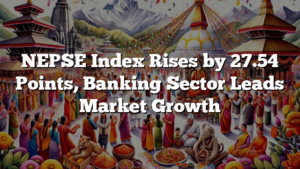
The Nepal Stock Exchange (NEPSE) encountered a challenging day on Monday, with the benchmark index plunging by 3.97 points, settling at 2079 points by the end of the trading session. This downturn in the NEPSE stock market index was accompanied by a notable reduction in transaction volumes, with a total turnover of Rs 4 billion, significantly lower than the previous day’s figure of Rs 4.31 billion.
The bearish sentiment pervaded the broader market, with 129 companies experiencing price declines, while only 110 companies managed to register gains. Meanwhile, 8 companies maintained their previous closing levels, reflecting the overall subdued trading activity.
Amidst the market turmoil, the microfinance sector emerged as a bright spot, showcasing resilience with a notable increase of 2.43 percent (106 points). However, the majority of other sectors experienced varying degrees of pullback, contributing to the overall market decline.
Specifically, the banking sector retreated by 8 points, while development banks witnessed a 12-point drop. The hotel and tourism industry saw a significant decline of 45 points, and the finance sector edged down by 0.06 points. The hydropower sector lost 3 points, and life insurance companies witnessed a 20-point decrease. The manufacturing and production sector fell by 69 points, while non-life insurance companies suffered a 71-point decline. The “others” category slipped by 6 points, and the business group index decreased by 1 point.
Despite the overall market weakness, a few standout performers emerged. Buddhabhumi Hydropower experienced the highest price increase, surging by an impressive 9.66 percent. Other notable gainers included Himalayan Microfinance, which climbed 6.9 percent, National Microfinance with a 6 percent rise, and Global IME Microfinance, also advancing by 6 percent.
As the NEPSE stock market navigates this turbulent phase, investors and market participants will closely monitor the performance of key sectors and the potential for a rebound, while remaining vigilant about the factors influencing market sentiment and overall economic conditions.
Related:



